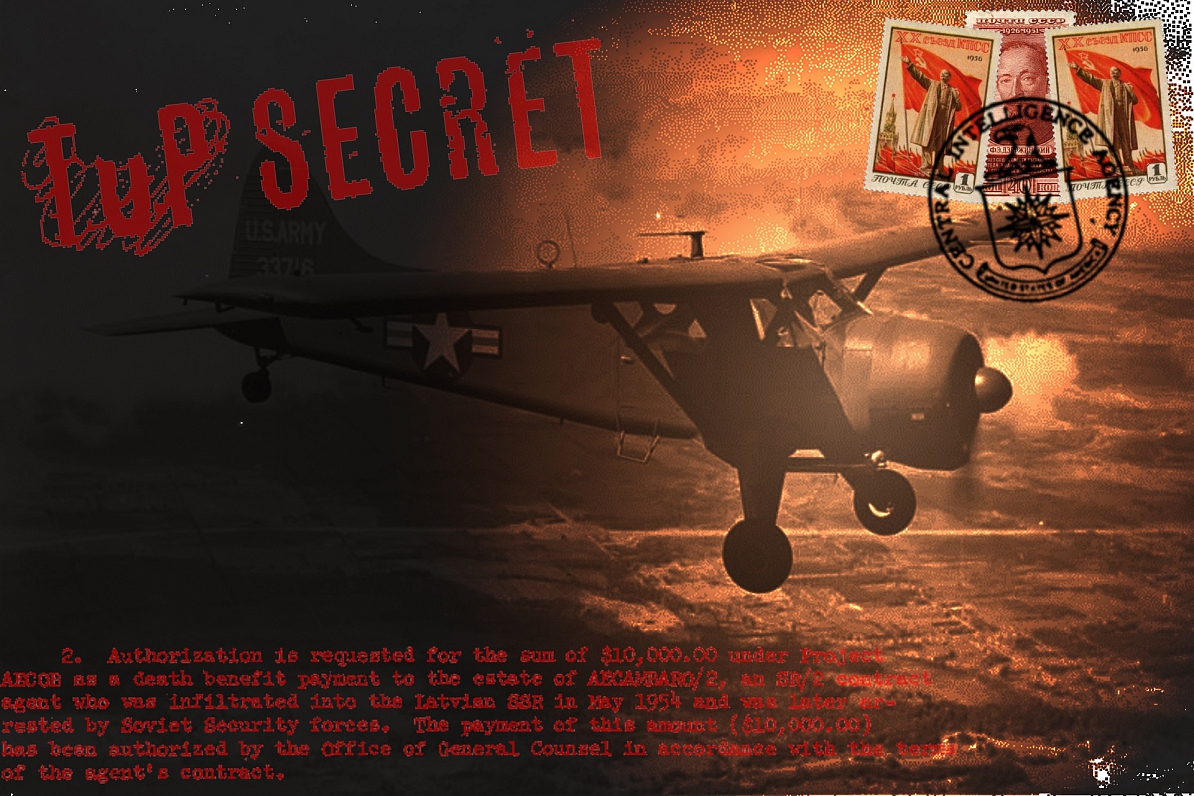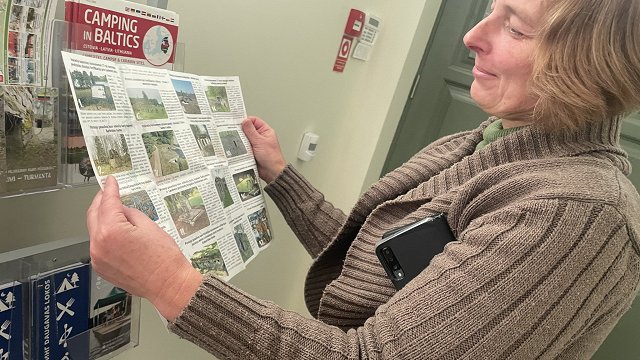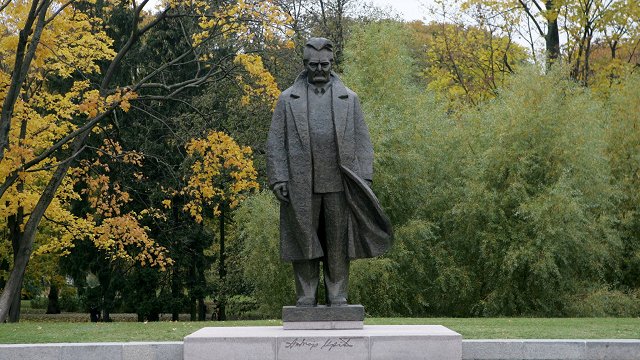By 1955 the agency thought it had a sufficient network of agents and sub-agents within Latvia, even though at least one of them was controlled by the KGB. About a dozen people are referred to in the documents.
The agents, their equipment and motivation
According to the project, called AECOB/ZRLYNCH and aimed at espionage and sabotage of the Soviets, the agents were equipped with "W/T sets, S/W material, personal arms, cameras, L and K tablets [stimulants and poison], Soviet-type clothing, sterile concentrated foods, rubles and bribery and barter items".
An October 8, 1952 report describes a number of agents involved in the operation: "CAMBAR0/1 (in Germany), [deleted] (in the U.S.), CAMBARO/2 (in Germany), CAMUSO/11 (in Germany), CAMUSO/12 (in Germany), and three agents now being trained in Germany for dispatch into the Latvian SSR."
It further says that "both the British and the Swedes claim to have agents in Latvia. When it is to the advantage of CIA, and when circumstances warrant it, the British and the Swedes may be advised of certain aspects of Fl operations."
Two of the agents were apparently offered immigration, and their contracts had clauses that their relatives would be paid $10,000 if they die during service.
Another report, dated November 1, profiles the agents.
"a. AECAMUSO/2, Herbert Okalo (p), escaped from Latvia to Sweden and was recruited there in 1951. Prior to this he had fought the Russians, first under the German-sponsored Latvian legion and then with Partisan groups. He was trained .and re-infiltrated in 1952 and has been in contact by S/W. Hqs. transmits to him by W/T. He has successfully lived in Latvia despite a skirmish with Soviet troops which resulted in the loss of most of his equipment and funds. He has also recruited two legal sub-agents within Latvia. It is planned to exfiltrate him. He is witting of AIS [intelligence agency] sponsorship of his activities.
b. AECAMBARO/2, Lyman M. Hameret (p) He has the same background as AECAMUSO/2. In Sweden he organized a Latviah Contacts group to carry on the Partisan fight. He was recruited in 1551 and was taken to Germany where he recruited AECAMUSO/3 and helped train the other AECAMUSOs. He then came to the US and assisted in AEBIAS/2's training. He was dispatched to the Latvian SSR in 1954 with the mission of exfiltrating AECAMUSO/2 ... He is witting of CIA sponsorship of his activities."
The report then describes four sub-agents, who are both former members of the Latvian Legion. They were recruited inside Latvia. One of them was a locksmith and mechanic, another one a garage manager, one a school teacher while another one a former German intelligence agent.
Another agent, code name AECAMUSO/3 was believed to be under Soviet control but the CIA kept in touch to try to keep him alive.
"All infiltrated agents have been given false documentation. To exfiitrate they probably must rely on CIA assistance. They also know that CIA controls salary payments being held for them. All agents are primarily motivated by a passionate hatred for the Soviets."
The document mentions several exfiltration attempts of AECAMUSO/2 and AECAMBARO/2, described in more detail elsewhere.
First attempt to flee Latvia
A June 28, 1955 memorandum addressed to the head of the CIA proposes evacuating one of their agents that successfully set up a network inside Latvia. Incredibly, they were able to make it some 1,900 km to Murmansk to try and cross the border between the USSR, Finland and Norway.
"The background and present status of the case: CAMUSO/2 ... was dispatched by air in August 1952 to the Latvian SSR. As regards the other two agents with whom CAMUSO/2 was dispatched, one missed the DZ and failed to effect a rendezvous. The first message from him indicated he had been captured. The other agent maintained contact with CAMUSO/2 according to plan. However, the two were ambushed by troops on the morning subsequent to dispatch and during the ensuing skirmish, CAMUSO/2's companion was killed.
CAMUSO/2 managed to escape and was able to reach one of his support points in Riga safely. In the process, however, he was forced to abandon a good deal of operational equipment and almost all of his operational currency.
In spite of such an inauspicious beginning ... CAMUSO/2 continued to carry out his assignment and did in fact complete it successfully. In the course of his activities he recruited and trained two internal resident agents, developed two cut-outs for receipt of communications, and arranged for two separate safehouse facilities ...
It soon became apparent, however, that he had no possibility of exfiltrating by utilizing his own resources alone, and it was therefore incumbent upon us to furnish the assistance required," the report reads.
"Accordingly, it was decided to dispatch CAMBARO/2 in order that he could provide the necessary briefing and assistance to effect CAMUSO/2's exfiltration. CAMBARO/2 is a former Latvian Army officer and police official who was recruited by this Agency in Sweden in 1951. He is an extremely powerful man physically and at the same time highly competent mentally ...
CAMBARO/2 was dispatched by air to the Latvian SSR in May 1954. Whether due to insufficient altitude or faulty timing by CAMBARO/2 ... the agent was unable to disengage his jump container and hit the ground with the 100 pound-plus pack still strapped to his body. As a result, he seriously injured his knee and dislocated one ankle; he was, however, still capable of some movement and was able to leave the area and proceed according to his briefing ...
He spent the summer assessing and reorganizing CAMUSO/2's assets and despite his instructions to the contrary, also recruited and trained two additional resident agents and developed and briefed three support point/safehouse facilities."
"As soon as the conditions of darkness and terrain were appropriate, the two agents set out on their exfiltration attempt after first sending an advance scout. to . reconnoitre the route.
They were able to reach Murmansk without difficulty; however, here they encountered extremely stringent security controls due to the route's compromise by the capture of the two Estonian agents that summer. The agents attempted to implement their alternate plan and cross the Tuloma River 40 kilometers south Of Murmansk. However, in traveling at night over the rocky terrain, CAMBARO/2 dislocated his previously injured ankle and no further progress was possible.
The severity of his injury may be judged by the fact that whereas the two agents reached the 40 kilometer point in two nights, they required seven nights in order to return after the accident. They were able to return safely to Riga by rail, a distance of some 1200 miles, and requested further instructions from us."
It was decided to try to rescue the agents by way of Gotland but the CIA was not able to secure refueling rights on Gotland and delayed the operation until it was no longer dark enough to mount the operation.
The document also includes a letter from one of the agents describing his activities and disaffect with the CIA's attempts to exfiltrate him.
"What is one to do next? You do not say anything about that in your messages and only warn me to lay low and refrain from any compromising act. Am I to understand this in such a way that I should do nothing on my part, but should only wait for your instructions? I urge you again to please send me a reply as speedily as possible, since the summer is short, and let me know if I have good reason to hope that we shall be able to leave here in the fall.
Mere promises "to do everything possible" do not satisfy me any more. The second exfiltration alternative which I mentioned in my last message is no longer valid from my present point of view."
Failed attempt to exfiltrate agents by airplane
Another document, dated October 3, 1955 describes an attempt by the CIA to use a Danish airfield to extricate the two unhappy agents by plane.
The agency used "magnetic anomalies" as a cover to use the airfield at Bornholm and even had a duplicate airplane to return to the airfield should the one which left be compromised. CAMUSO/2 and CAMBARO/2 were instructed to mark the landing site with lights, but an apparent navigation failure prevented them from being freed from their dire circumstances.
"The mission aircraft returned to Bornholm ... without landing at the target area. A debriefing of the navigator and pilot indicated that the route had been flown as planned ... Although they reported seeing lights on an open field, which they judged to be the Landing Zone, the observed lights were not in the proper L pattern nor was a recognition signal seen. The crew had concluded that this could not be the intended LZ and spent approximately 25 minutes flying around the general area in search of a proper light pattern. No identifiable light pattern was observed, and the aircraft returned to base ..."
The document ended with a recommendation to try again, but the Danes apparently no longer believed the "magnetic anomaly" story and thus the German airfield of Bremerhaven was used.
Last attempt to fly agents home
The same year before Christmas the agency tried again, this time using the German airfield. This time it was the pilots who weren't up to the task of flying across the border under cover of darkness.
What follows are excerpts from an April 10, 1956 report.
"The second mission was launched on the night of 20-21 December 1955. This one aborted. The aircraft returned to base after traversing less than one-third the outbound leg. The agent-aviators claimed they got lost. Their debriefing, however, did not substantiate their claim. It suggested, moreover, their story was fabricated by motives of fear, and established their intent of refusing another try. At a subsequent date the service of these agent-aviators was terminated.
The authors of the report did what they could to preserve their agents and requested that a resupply mission is launched.
They recommended that, "prior to the time that the above agent-aviators are available and capable to fly the evacuation mission, [the agency] mount an air-resupply drop operation as soon as possible to provide our agents with funds, supplies and equipment, the latter to include a homing' device for facilitating a subsequent air or sea exfiltration operation."
An April 30 report takes on a desperate tone, pleading the agency's higher-ups to greenlight a resupply operation.
The situation is indeed dire. "Due to several false alerts and three abortive attempts at air exfiltration, both agents are convinced that we have no intention of sending an aircraft into Latvia and consider this phase of the operation to be notional ... The first agent has stated that he would monitor our broadcasts only until the end of June and if nothing concrete were forthcoming would thereupon quit ... The second agent has indicated a determination not to await an inevitable end but to make every effort to escape the country this summer."
Possible death at hands of Soviet intelligence
No further attempts to rescue both agents are mentioned in the CIA documents.
However two cablegrams shed light on their fates.
The first reads: "Soviet Latvian newspapers, CĪŅA and SOVETSKAYA LATVIYA, began 26 Nov serial account spy activities .. article also surfaces Riekstins, Herbert, and Boris. First two resided Sweden before proceeding Germany for AIS training. Idens follow. Petersons ... accused of playing leading role in action described"
Two additional cablegrams confirm the agents' identities and confirm that they're indeed agents AECAMUSO 1,2,3.
"A - Alfrēds Riekstiņš, B - Edvīns Ozoliņš, C - Nikolajs Bolodis (sic.)" ... "CRYPTS FOR REF IDENS AECAMUSO 1, 2, 3."
The last document they're mentioned in, dated March 11, 1958, reveals the approximate timeline of the incidents.
"AECAMBARO/2 ... was dispatched on a mission to Latvia 6/7 May 1954 and maintained contact with us until December 1956. Since that time he did not reply to our messages. On 25 September 1957, the Soviet press announced that the apprehension of AECAMBARO/2 took place in July 1957. ..
AECAMUSO/2 ... was dispatched 26 August 1952. He had been in contact with us until December 1956. Since then he has not replied to our messages. In his S/W message, dated 23 March 1956, he said he had settled down in a quiet spot and discontinued contact with his "helpers". His S/W message of 15 October 1956 stated that, while he was fed up with the whole "matter", he had no choice but to wait another three months for money from us. His last S/W message, dated 7 December 1956, contained text too illegible to be understood."


























